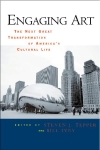« Another Picture | Main | Thanks for Playing »
June 21, 2007
Realtime Panel Discussion
by Molly SheridanSteve Tepper has kicked off the live discussion portion of this event with an audience survey. How many people use current technology features--message boards, podcasts, blogs, YouTube, video previews of their concerts--within their own organizations? The result: Not very many. But Conner suggests it will be important to develop in these areas if we want to attract young people who are interested in music in general. Bertozzi says that deepening technology will be mirrored by a desire to engage in live performances.
Conner says we do not "bowl alone". People are spending money going out; they're not home watching TV. But they're not necessarily in the concert hall. Gillinson stresses the fundamental shift that has a occurred on both sides of the pond due to a general lack of education in the arts. And the older people get, the more threatened they are by having to learn new things.
Q: Many people attend student concerts but not professional groups. Why?
McBurney suggests it's an issue of expense. Gillinson follows up that it's just an individual preference. Assink adds that it's not just cost, but also a connection to knowing the people making the music.
Q: How can an orchestra participate in unleashing the creativity of their audiences beyond public school education?
Assink says we need to connect with families, not just schools, when it comes to educating young people, supporting their child's musical training.
Q: Do we need money to do these things? What's the equation?
Conner: What we've discovered in Pittsburgh is that the money is incredibly important because you need to have talented mediators, not overburden/overworked individual doing other jobs in staff. It fails without dedicated individuals in those roles.
Q: In today's environment, how are we going to build our audience?
Assink suggest that on the low-tech side, why don't we have music clubs like we have book clubs.
McBurney says in Chicago they are using more elaborate screen projections that try to expand people's astonishment at what they can see. Close up images of a performer's manuscript to see what it is like. Also helps deal with the issue of intimate experience in large spaces.
Gillinson doesn't feel you need to be a musician to enjoy this music, but we are perceived a forbidding and we have to reach out much more.
Ivey takes the stage to conclude the session. He notes the hard line between the authors on the first half who saw big change ahead, as compared with the administrators who spoke during the second half and said things are not that bad and maybe we just need to proceed doing the excellent work that orchestras do.
But Ivey wonders: Who will be the future participants? Gen X and Y like music because "it is the soundtrack of life" and "it's a badge of cool." There are problems and opportunities there for the symphonic field. They like choice and control, they want all access (before/after/onstage and off). They want skillful, meaningful content, and they're looking for people to lead them. Passive, lackluster shows will not interest them.
Whew! We (and the technology) made it. Thanks for reading and writing in!
Posted by msheridan at June 21, 2007 3:09 PM
COMMENTS
Post a comment
Tell A Friend
Resources
Engaging Art: The Next Great Transformation of America's Cultural Life Chapter downloads MP3s Vanessa Bertozzi on audiences and participation Vanessa Bertozzi on involving artists in work Steven Tepper argues the historical context of arts in America
Abstracts
Chapter 4
In & Out of the Dark - (a theory about audience behavior from Sophocles to spoken word)
Chapter 7
Artistic Expression in the age of Participatory Culture (How and Why Young People Create)
Chapter 8
Music, Mavens & Technology
(all chapters in pdf form)
Steven Tepper talks about technology and the future of cultural choice
Lynne Conner on the historical relationship between artist and audience
Lynne Conner on event and meaning and sports
AJ Blogs
AJBlogCentral | rss
culture
Terry Teachout on the arts in New York City
Andrew Taylor on the business of arts & culture
rock culture approximately
Rebuilding Gulf Culture after Katrina
Douglas McLennan's blog
Art from the American Outback
Scott McLemee on books, ideas & trash-culture ephemera
Jan Herman - arts, media & culture with 'tude
dance
Apollinaire Scherr talks about dance
Tobi Tobias on dance et al...
media
Jeff Weinstein's Cultural Mixology
Martha Bayles on Film...
music
Greg Sandow performs a book-in-progress
Howard Mandel's freelance Urban Improvisation
Focus on New Orleans. Jazz and Other Sounds
Exploring Orchestras w/ Henry Fogel
Kyle Gann on music after the fact
Doug Ramsey on Jazz and other matters...
Greg Sandow on the future of Classical Music
Norman Lebrecht on Shifting Sound Worlds
publishing
Jerome Weeks on Books
visual
Public Art, Public Space
John Perreault's art diary
Lee Rosenbaum's Cultural Commentary
Tyler Green's modern & contemporary art blog
Special AJ Blogs
June 14-20, 2007



